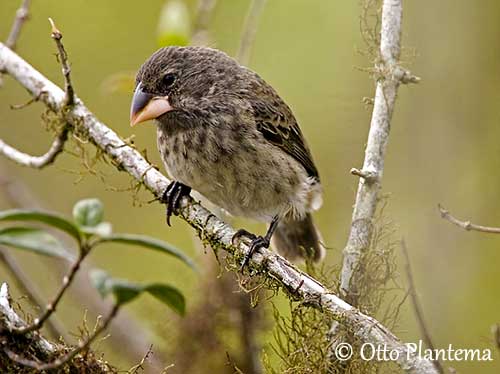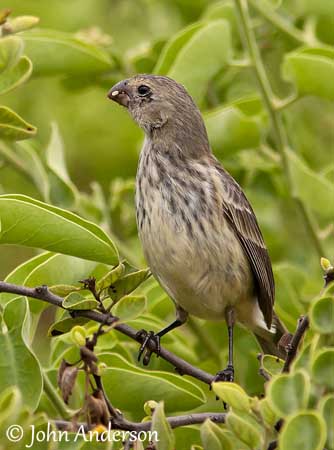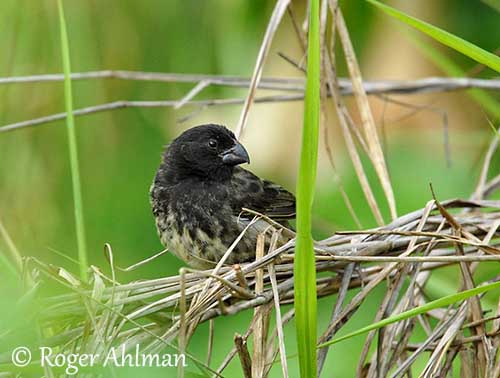
Fr: Géospize crassirostre
All: Dickschnabel-Darwinfink
Esp: Pinzón de Darwin Vegetariano
Ita: Fringuello arboricolo beccogrosso
Nd: Vegetarische Boomvink
Sd: Tjocknäbbad trädfink
Photographers:
Roger Ahlman
Pbase Galleries Peru and Ecuador
John Anderson
John Anderson Photo Galleries
Otto Plantema
Trips around the world
Text by Nicole Bouglouan
Sources:
HANDBOOK OF THE BIRDS OF THE WORLD Vol 16 by Josep del Hoyo- Andrew Elliot-David Christie – Lynx Edicions – ISBN: 9788496553781
BirdLife International (BirdLife International)
Wikipedia, the free encyclopaedia
Vegetarian Finch
Platyspiza crassirostris
Passeriformes Order – Thraupidae Family
Darwin’s Finches - Generalities
INTRODUCTION:
After the Large Ground-Finch’s largest bill, the Vegetarian Finch is one of the largest Darwin’s Finches. It has more vertical stance, with longer tail than others. It is the sole member of the genus Platyspiza, and an endemic species to the Galapagos Islands.
The English name “Vegetarian Finch” refers to its primary diet, and this species is really a true vegetarian bird.
DESCRIPTION OF THE BIRD:
Biometrics:
Length: 16 cm
Weight: 29-40 g
The adult male has olive upperparts with blackish feather centres, especially on mantle. Upperwing and tail are dark brown with pale-edged feathers.
The underparts are whitish, streaked dark on lower breast and flanks, whereas lower flanks and undertail-coverts are buffy.
The male has black head, like a hood. The black continues down to throat, upper breast and upper flanks.
The bill has strongly curved culmen and broad, almost parrot-like stout structure. It is black, but during the non-breeding period, the lower mandible is horn-coloured. The eyes are dark brown. Legs and feet are blackish.
Some variants are reported with buffy-white underparts streaked blackish.

The adult female is brown with streaked crown, face and upperparts. The rump is buffy. Upperwing and tail are brown, and we can see two weak pale buff wingbars.
The underparts are whitish with brown streaks on throat, breast and flanks, whereas the lower flanks are washed buff.
She has the same bill shape that the male, but with dark brown to blackish upper mandible and dull orange or pinkish lower mandible.
The immature male is intermediate between male and female plumages, with only blackish face and throat, and more streaked underparts than the adult male.
RANGE:
The Vegetarian Finch occurs on several Galapagos Islands such as Pinta, Marchena, Fernandina, Isabela, Santiago, Rábida, Pinzón, Baltra, Santa Cruz, Floreana and San Cristobal.
HABITAT:
The Vegetarian Finch is usually most common in montane evergreen forest, in transition area. But it also frequents more arid zones in lowlands, and humid areas at higher elevation.
CALLS AND SONGS: SOUNDS BY XENO-CANTO
The Vegetarian Finch’s call is a high-pitched “tzeeeeiiiiiiiiiipppppp”, something similar to electronic sound coming from a radio. This is the most extreme sound produced by a Darwin’s Finch. It also gives a plaintive “pheep”.
The song is long, a nasal drawn-out sound, stronger towards the end and sometimes interspersed with squeals “ph’ wheeeuuuuuu-iiiuuu”.
BEHAVIOUR IN THE WILD:
As indicated by its name, the Vegetarian Finch feeds mainly on plant matter such as leaves, flowers, buds and fruits. However, some insects are occasionally caught.
This species has peculiar habit of stripping bark from Croton Scouleri twigs, in order to reach the sugar-rich inner parts of this plant.

The Vegetarian Finch may feed both on the ground where it takes fallen fruits, and in trees, mostly at mid-level. Outside the breeding season, they can forage in large, mixed-species flocks.
The breeding season is closely associated with rainfall. Pairs are monogamous, but there are some mate changes, and from observations, several mates have been reported.
The male displays outside a display-nest, in order to attract a female. Once the pair is formed, both mates build the actual nest. The pair maintains a small territory during the breeding season.
The Vegetarian Finch is resident, and only performs short flights within its range.
REPRODUCTION OF THIS SPECIES:
The breeding season takes place mainly during the wet season, when there are abundant food resources.
The nest is a dome-shaped structure with a side entrance. It is placed in bush or in cactus. It is made with dry grasses.
The female lays 3 eggs. The incubation lasts about 12 days. The chicks fledge two weeks after hatching.
This species can produce several broods per year in suitable conditions.
PROTECTION / THREATS / STATUS:
The Vegetarian Finch is relatively common and widespread in its range. Like other Darwin’s Finches, this species is threatened by destruction and degradation of the habitat by increasing tourism and human population growth. Introduced predators and diseases are important threats too.
But currently, the Vegetarian Finch is not globally threatened.
